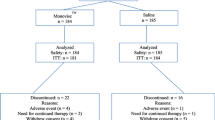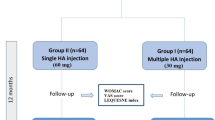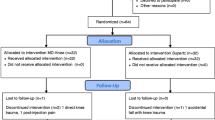Abstract
This paper aims to compare the results of single-joint knee vs hip hyaluronic acid (HA) injections in patients with osteoarthritis (OA) involving both the knee and hip joints. Thirty-eight patients who were diagnosed to have both hip and knee OA were enrolled. Patients were divided into two groups to receive HA injection three times at 1-week intervals either to the hip or knee joints. Pain level during activities and rest was measured by using visual analog scale (VAS). Western Ontario and McMaster University Osteoarthritis Index (WOMAC 5-point Likert 3.0) was also used prior to the injections and 1 month after the 3rd injection. In the knee injection group, the intragroup analysis revealed significant improvements in VAS activity pain, VAS rest pain, and WOMAC pain values following injection when compared with preinjection values, while no significant difference was detected in WOMAC stiffness, WOMAC physical function, and WOMAC total values. In the hip injection group, VAS activity pain, VAS rest pain, WOMAC pain, WOMAC stiffness, WOMAC physical function, and WOMAC total values showed significant improvement after the injection when compared with preinjection values. Although statistically not significant (p > 0.05), the comparison of the differences (preinjection–postinjection) between the groups demonstrated higher values in the hip injection group. We imply that intra-articular single-joint HA injections either to the knee or hip joints in OA patients with involvement of both of these joints are effective with regard to pain and functional status.
Similar content being viewed by others
Avoid common mistakes on your manuscript.
Introduction
Osteoarthritis (OA) is the most common chronic joint disease worldwide and it is one of the most significant causes of disability and chronic pain in the elderly population [1]. Concerning the two major weight-bearing joints, the risk factors for OA of the knee and hip joints show similarities. Further, the principles of therapy are almost the same [2]. For both joints, patient training, weight loss, muscle-strengthening exercises, supportive devices, physical therapy agents, paracetamol, nonsteroidal anti-inflammatory drugs, and intra-articular injections are the most preferable nonsurgical modalities of treatment [3].
Regarding intra-articular injections, hyaluronic acid (HA) supplementation has been shown to provide symptom management and decrease the rate of deterioration of joint structure [4, 5]. It has been also included in the OA recommendations by the European League Against Rheumatism and American College of Rheumatology [6, 7]. Intra-articular HA application is mostly preferred for the knee joint; however, it has been increasingly used recently also in hip OA. There are numerous trials investigating the effects of intra-articular injections in isolated single-joint groups either in hip or knee OA [8, 9]. However, to our best notice, there are no studies evaluating the effects of HA injections in patients with respect to both their knee and hip joint involvements. Accordingly, this trial was designed to compare the results of single-joint knee vs hip HA injections in patients with OA involving both the knee and hip joints.
Materials and methods
Thirty-eight patients who were diagnosed to have both hip and knee OA according to the American College of Rheumatology criteria [10, 11] and who were classified to have radiological stages of I or II according to Kellgren and Lawrence [12] were recruited. Patients with active synovitis, limited knee/hip joint range of motions, trauma, surgical intervention, or intra-articular injection within the last 6 months in the hip/knee joints were excluded.
According to the order of presentation to our outpatient clinic, patients were divided subsequently into two groups, one patient assigned to the knee injection group and the next to the hip injection group. In both groups, patients received single-joint injections three times at 1-week intervals. The side to be injected (right vs left) was decided according to the complaints of the patients. All patients were informed about the procedure and they gave written consent to participate.
The knee joint injections were performed under sterile conditions by inserting a 21-gauge needle into the patellofemoral joint space by superolateral approach while the patients were in supine position. The hip joint injections were performed under sterile conditions on fluoroscopy by inserting an 18-gauge 90-mm needle close to the femoral neck 1 cm over the trochanter major while the patients were in lateral decubitis position (Fig. 1).
In both groups, pain level during activities and rest was measured by using visual analog scale (VAS). Western Ontario and McMaster University Osteoarthritis Index (WOMAC 5-point Likert 3.0) was also used prior to the injections and 1 month after the 3rd injection [13].
SPSS 15.0 software was used for analysis. Paired-sample t test was used for comparing parametric variables before and after the injections in each group. Chi-squared test was used for comparing categorical variables and Mann Whitney U test was used in case variables did not display a normal distribution.
Results
Demographic and clinical characteristics of the patients are summarized in Table 1. The two groups were statistically similar in this regard. In the knee injection group, the intragroup analysis revealed significant improvements in VAS activity pain, VAS rest pain, and WOMAC pain values following injection when compared with preinjection values, while no significant difference was detected in WOMAC stiffness, WOMAC physical function, and WOMAC total values (Table 2). In the hip injection group, VAS activity pain, VAS rest pain, WOMAC pain, WOMAC stiffness, WOMAC physical function, and WOMAC total values showed significant improvement after the injection when compared with preinjection values (Table 3). Although statistically not significant (p > 0.05), the comparison of the differences (preinjection–postinjection) between the groups demonstrated higher values in the hip injection group. An adverse event due to injections did not occur in any of the patients.
Discussion
In this study, we have compared the results of knee vs hip joint injections in patients with both knee and hip OA. Both groups showed improvement regarding pain and functional parameters. Although the differences between the groups were higher in the hip joint group, they were statistically not significant.
Among the weight-bearing joints of the body, the two most common joints involved in OA are knee and hip joints, respectively [1, 14]. Intra-articular HA injection is most commonly administered to the knee joint [15]. A meta-analysis by Aggrawal et al. [9] reported that administration of viscosupplementation with HA to the knee joint is a good therapeutical choice in patients who do not respond to conservative treatment or those who are not eligible for surgery. Another important point for choosing HA is the grade of the pathology. In human and animal studies, it has been shown that intra-articular HA was not effective in high-grade OA [16, 17]. Likewise, we have included early-stage OA patients in our study.
In one meta-analysis, it was demonstrated that significant improvements with limited undesirable effects ensued in activity pain, resting pain, and functional status [18]. On the other hand, Arrcih et al. [17] indicated that most of the relevant trials had low methodological quality and that, although HA was superior to placebo with respect to the effects on activity pain, it was not effective on resting pain and did not enhance joint function. When compared with studies on knee joint HA injections, fewer trials have been performed on HA injection in hip OA. Significant improvements in pain, functional status, and duration of pain-free walking have been observed in such studies [19–22].
All of the above-mentioned trials were performed in patients with either hip or knee OA. However, in daily practice, physicians come across many patients with both knee and hip involvement. These two joints are also closely related from the biomechanical point of view and, in cases of concomitant hip and knee OA, patients’ functional status would be affected by both joints. Our results demonstrated that intra-articular HA injection in either of these two joints might provide significant improvements in pain (VAS activity and VAS rest, WOMAC pain). Moreover, injections to the hip joint also displayed beneficial effects on WOMAC stiffness, WOMAC physical function, and WOMAC total values.
The most important limitation of our trial was the lack of a long-term follow-up; as such, our results are applicable only for the early stage. Another drawback of our study would be the absence of a group in which both knee and hip joint injections could have been performed. Such a group was not included first due to the fact that hip injections are not simple interventions and usually require fluoroscopic or sonographic guidance and second due to the fact that two simultaneous injections are generally not preferred by the patients.
To summarize, in the light of our first and preliminary results, we may conclude that intra-articular single-joint HA injections either to the knee or hip joints in OA patients are effective with regard to pain and functional status. In this sense, we imply that, during the management of patients with OA, both knee and hip joints should be taken into consideration alike. Further, according to the experience of the physicians, HA injections either in the knee or hip joints can be planned. Long-term follow-up results after such injections remain to be investigated in future studies.
References
Zhang Y, Jordan JM (2008) Epidemiology of osteoarthritis. Rheum Dis Clin North Am 34:515–529
Bierma-Zeinstra SM, Koes BW (2007) Risk factors and prognostic factors of hip and knee osteoarthritis. Nat Clin Pract Rheumatol 3:78–85
Diracoglu D (2007) Intra-articular hyaluronic acid in the management of osteoarthritis. Turk J Phys Med Rehab 53:154–159
Migliore A, Granata M (2008) Intra-articular use of hyaluronic acid in the treatment of osteoarthritis. Clin Interv Aging 3:365–369
Das SK, Farooqi A (2008) Osteoarthritis. Best Pract Res Clin Rheumatol 22:657–675
Jordan KM, Arden NK, Doherty M et al (2003) EULAR recommendations 2003: an evidence based approach to the management of knee osteoarthritis: Report of a Task Force of the Standing Committee for International Clinical Studies Including Therapeutic Trials (ESCISIT). Ann Rheum Dis 62:1145–1155
American College of Rheumatology Subcommittee on Osteoarthritis Guidelines (2000) Recommendations for the medical management of osteoarthritis of the hip and knee: 2000 update. Arthritis Rheum 43:1905–1915
van den Bekerom MP, Lamme B, Sermon A, Mulier M (2008) What is the evidence for viscosupplementation in the treatment of patients with hip osteoarthritis? Systematic review of the literature. Arch Orthop Trauma Surg 128:815–823
Aggarwal A, Sempowski IP (2004) Hyaluronic acid injections for knee osteoarthritis. Systematic review of the literature. Can Fam Physician 50:249–256
Altman R, Asch E, Bloch D, Bole G et al (1986) Development of criteria for the classification and reporting of osteoarthritis. Classification of osteoarthritis of the knee, diagnostic and therapeutic criteria Committee of the American Rheumatism Association. Arthritis Rheum 29:1039–1049
Altman R, Alarcon G, Appelrouth D (1991) The American College of Rheumatology criteria for the classification and reporting of osteoarthritis of the hip. Arthritis Rheum 34:505–514
Kellgren JH, Lawrence JS (1957) Radiological assessment of osteo-arthrosis. Ann Rheum Dis 16:494–502
Tüzün EH, Eker L, Aytar A, Daşkapan A, Bayramoğlu M (2005) Acceptability, reliability, validity and responsiveness of the Turkish version of WOMAC osteoarthritis index. Osteoarthritis Cartilage 13:28–33
Oliveria SA, Felson DT, Reed JI, Cirillo PA, Walker AM (1995) Incidence of symptomatic hand, hip, and knee osteoarthritis among patients in a health maintenance organization. Arthritis Rheum 38:1134–1141
Shoor S (2006) Review: viscosupplementation for knee osteoarthritis reduces pain and improves function. Evid Based Med 11:12
Takahashi K, Goomer RS, Harwood F, Kubo T et al (1999) The effects of hyaluronan on matrix metalloproteinase-3 (MMP-3), interleukin-1beta(IL-1beta), and tissue inhibitor of metalloproteinase-1 (TIMP-1) gene expression during the development of osteoarthritis. Osteoarthritis Cartilage 7:182–190
Wang CT, Lin YT, Chiang BL, Lin YH, Hou SM (2006) High molecular weight hyaluronic acid down-regulates the gene expression of osteoarthritis-associated cytokines and enzymes in fibroblast-like synoviocytes from patients with early osteoarthritis. Osteoarthritis Cartilage 14:1237–1247
Wang CT, Lin J, Chang CJ, Lin YT, Hou SM (2004) Therapeutic effects of hyaluronic acid on osteoarthritis of the knee. A meta-analysis of randomized controlled trials. J Bone Joint Surg Am 86-A:538–545
Arrich J, Piribauer F, Mad P, Schmid D, Klaushofer K, Müllner M (2005) Intra articular hyaluronic acid for the treatment of osteoarthritis of the knee: systematic review and meta-analysis. CMAJ 172:1039–1043
Bragantini A, Molinaroli F (1994) A pilot clinical evaluation of the treatment of hip osteoarthritis with hyaluronic acid. Curr Ther Res 55:319–330
Migliore A, Tormenta S, Massafra U et al (2008) Intra-articular administration of hylan G-F 20 in patients with symptomatic hip osteoarthritis: tolerability and effectiveness in a large cohort study in clinical practice. Curr Med Res Opin 24:1309–1316
Conrozier T, Bertin P, Bailleul F et al (2006) Clinical response to intra-articular injections of hylan G-F 20 in symptomatic hip osteoarthritis: the OMERACT-OARSI criteria applied to the results of a pilot study. Joint Bone Spine 73:705–709
Disclosures
None
Author information
Authors and Affiliations
Corresponding author
Rights and permissions
About this article
Cite this article
Dıraçoğlu, D., Alptekin, K., Teksöz, B. et al. Knee vs hip single-joint intra-articular hyaluronic acid injection in patients with both hip and knee osteoarthritis: a pilot study. Clin Rheumatol 28, 1021–1024 (2009). https://doi.org/10.1007/s10067-009-1199-7
Received:
Revised:
Accepted:
Published:
Issue Date:
DOI: https://doi.org/10.1007/s10067-009-1199-7





